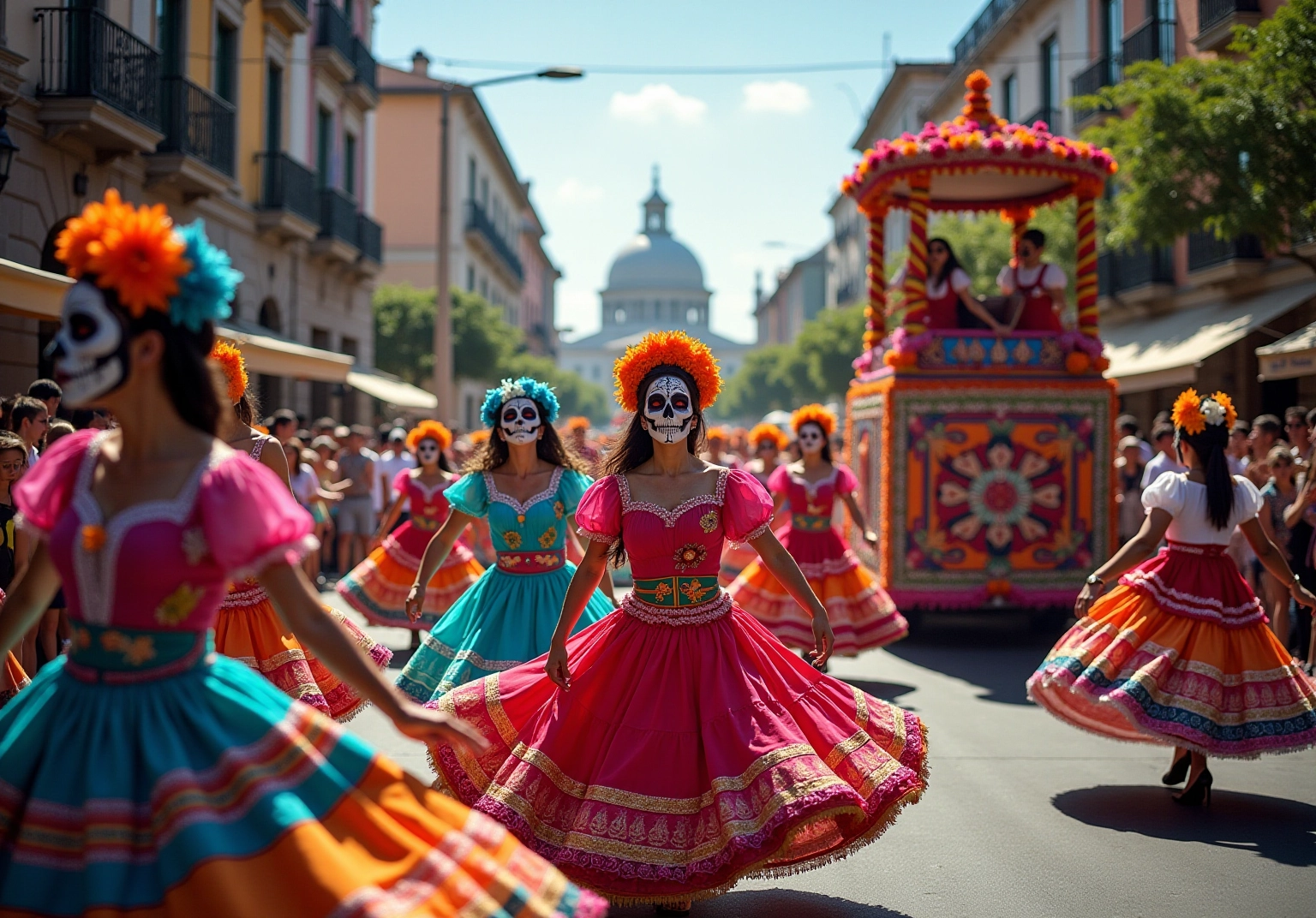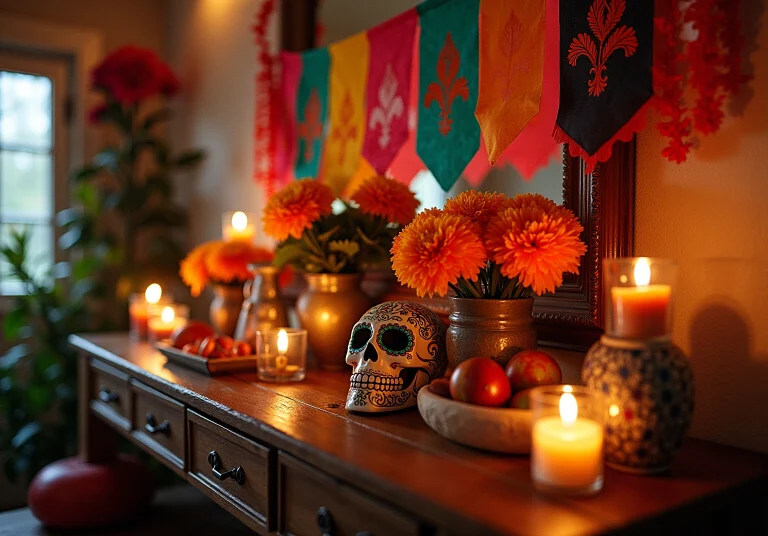Overview
Día de los Muertos festivities in Mexico are a vibrant celebration that honors our dearly departed. You’ll find traditions like creating ofrendas (altars) and joining in regional events that truly bring this celebration to life! These customs, rooted in ancient Mesoamerican cultures and recognized by UNESCO, beautifully reflect a blend of indigenous and Spanish influences. It’s fascinating how they showcase the deep cultural significance of remembering and celebrating life through community gatherings and symbolic offerings. So, if you’re looking for an unforgettable experience, this is definitely one to explore!
Key Highlights:
- Día de los Muertos is a vibrant Mexican tradition honouring deceased loved ones, rooted in ancient Mesoamerican cultures, particularly the Aztecs.
- The celebration occurs on November 1st and 2nd, aligning with Catholic observances like All Saints’ Day and All Souls’ Day.
- Ofrendas, or altars, are central to the tradition, featuring photographs, food, and mementos that symbolise the connexion between the living and the dead.
- Marigolds (cempasúchil) guide souls back, while papel picado and sugar skulls represent life’s fragility and sweetness, respectively.
- Modern Día de los Muertos is recognised by UNESCO as an intangible cultural heritage, emphasising its significance as a celebration of life.
- Celebrations vary regionally, with Mexico City hosting grand parades and Oaxaca offering intimate family gatherings in cemeteries.
- The festivities peak from October 29 to November 2, showcasing a rich tapestry of Mexican culture and community spirit.
Introduction
Día de los Muertos is a celebration rich in history and vibrant culture that invites you to embrace the delicate balance between life and death. This annual event, rooted in ancient Mesoamerican traditions, offers a unique opportunity to honor your departed loved ones through colorful altars, joyful gatherings, and rich customs that have evolved over centuries.
As the festivities draw near, it’s worth pondering: how can modern interpretations of these age-old rituals deepen our connection to both our ancestors and the living community? Let’s explore this together!
Understand the Significance and Origins of Día de los Muertos
Día de los Muertos, or the day of the dead festivities in Mexico, is such a vibrant tradition that beautifully honors our departed loved ones! With roots tracing back to ancient Mesoamerican cultures—especially the Aztecs—this celebration invites us to view death as a fundamental part of life’s cycle. Imagine this: during the day of the dead festivities in Mexico, the souls of those who have passed return to the realm of the living, and it’s celebrated on November 1st and 2nd, coinciding with Catholic observances like All Saints’ Day and All Souls’ Day. This rich blend of indigenous and Spanish customs creates an experience that’s truly unique!
The historical context of this celebration is fascinating! It highlights how important it is to honor our ancestors. In pre-Hispanic civilizations, rituals related to death were deeply ingrained in their culture. They created offerings, known as ofrendas, to invite back the souls of the deceased. These altars are often adorned with photographs, food, and mementos, each carrying its own significant meaning. For instance, marigold blooms symbolize the delicacy of existence, while the favorite dishes of those who have passed are set out to attract their spirits for a visit.
Over the centuries, these practices have evolved, reflecting a dynamic interplay between cultural traditions. The arrival of the Spanish added new elements to these rituals, leading to a beautiful syncretism of European and Indigenous practices that shape modern observances today.
In contemporary Mexico, the day of the dead festivities in Mexico, celebrated as Día de Muertos, is recognized by UNESCO as part of the country’s intangible cultural heritage. This emphasizes its significance not just as a day of remembrance, but as a celebration of life! Families come together to construct intricate altars, nurturing a bond between the living and those who have passed away. It’s a poignant reminder that as long as we remember, our loved ones are never truly lost. Memory, after all, is a powerful force that transcends death!
Explore Key Traditions and Customs of Día de los Muertos
Key traditions of the day of the dead festivities in Mexico center around the creation of altars, or ofrendas, which serve as sacred spaces for honoring our dearly departed. These altars come alive with photographs, cherished foods, and personal belongings that tell the stories of those we miss. One essential element of these offerings is the vibrant marigold, known as cempasúchil, whose bright colors and lovely fragrance are believed to guide souls back to their families. You’ll also find papel picado, symbolizing the wind and the fragility of life, along with monarch butterflies, thought to carry the spirits of the deceased. And let’s not forget the sugar skulls, or calaveras, which represent the sweetness of life and the inevitability of death, often personalized with names to honor the departed.
Families gather to celebrate with music, dance, and storytelling, diving into traditional activities like La Danza de los Viejitos. It’s all about creating a festive atmosphere that honors loved ones while strengthening community bonds. This celebration, especially during the day of the dead festivities in Mexico, isn’t just a time for remembrance; it’s a vibrant expression of life! Participants engage in joyful activities that reflect their rich cultural heritage. Understanding these customs not only enhances your experience of the festivities but also deepens your respect for the cultural significance behind each tradition. It beautifully highlights the interconnectedness of life and death in Mexican culture. As Carlos Fuentes wisely noted, “The Day of the Dead is not about mourning but about celebrating the everlasting journey of existence.
Discover Celebrations and Events During Día de los Muertos
The day of the dead festivities in Mexico is a vibrant celebration, with each region showcasing its unique cultural flair! In Mexico City, you can’t miss the grand parade, which is a highlight of the festivities. Picture colorful floats, lively dancers, and intricate costumes all coming together to attract over 3 million tourists each year! This lively exhibition not only pays tribute to the departed but also celebrates life itself, reflecting the essence of the day of the dead festivities in Mexico.
The festivities really peak around October 29 to 31, making it the perfect time for you to dive into the celebrations! Meanwhile, if you’re looking for something more intimate, Oaxaca offers a charming experience. Imagine streets adorned with vibrant altars and the sound of traditional music filling the air. Families gather in cemeteries, creating a lively atmosphere as they honor their loved ones with food, drinks, and shared stories.
Other regions, like Michoacán, host local festivals that include artisan markets and cultural performances, enriching your overall experience. Engaging in these celebrations allows you to immerse yourself in the rich tapestry of Mexican culture and the communal spirit that defines the day of the dead festivities in Mexico. With events running from October 11 to November 2, 2025, this year promises to be particularly special! The day of the dead festivities in Mexico will culminate in a series of parades and gatherings that reflect the deep-rooted traditions of this beloved holiday.
As Carlos Fuentes beautifully puts it, ‘Day of the Dead is not just a ritual; it’s the heartbeat of our culture, a tribute to our ancestors that lives in every vibrant color and every shared story.’ So, are you ready to experience this incredible celebration for yourself?

Conclusion
Día de los Muertos is such a vibrant celebration! It beautifully weaves together memory, culture, and community in Mexico. This festival not only honors those who have passed but also highlights the beauty of life itself. You’ll find a unique blend of ancient Mesoamerican traditions and Spanish influences that truly make this event special. It invites everyone to embrace death as a natural part of life’s cycle, fostering connections between the living and those who have departed.
As you dive into the festivities, you’ll discover key traditions like the creation of ofrendas, the use of marigolds, and lively community celebrations. These elements highlight the rich cultural significance of this holiday. Events such as parades in Mexico City and intimate gatherings in Oaxaca showcase the diverse expressions of Día de los Muertos across different regions. Each celebration offers a unique experience filled with joy and remembrance! The customs surrounding this festival deepen our respect for those who have come before us, reminding us that memory keeps our loved ones alive in our hearts.
Engaging in these festivities and understanding their significance provides profound insight into Mexican culture and the universal themes of life and death. As we look forward to the celebrations in 2025, I invite you to partake in this extraordinary tribute. Experience the colors, sounds, and stories that make Día de los Muertos a heartfelt celebration of existence. Let it inspire a deeper appreciation for the connections we share with those who have touched our lives!
Frequently Asked Questions
What is Día de los Muertos?
Día de los Muertos, or the Day of the Dead, is a vibrant Mexican tradition that honors departed loved ones, celebrating their return to the realm of the living on November 1st and 2nd.
What are the origins of Día de los Muertos?
The origins of Día de los Muertos trace back to ancient Mesoamerican cultures, particularly the Aztecs, who viewed death as a fundamental part of life’s cycle.
How is Día de los Muertos celebrated?
Celebrations include creating ofrendas (offerings) adorned with photographs, food, and mementos to invite the souls of the deceased back for a visit, reflecting a blend of indigenous and Spanish customs.
What is the significance of ofrendas?
Ofrendas are altars that symbolize the connection between the living and the deceased, often featuring marigolds and the favorite dishes of those who have passed, each carrying its own meaning.
How has Día de los Muertos evolved over time?
The practices have evolved through a dynamic interplay of cultural traditions, particularly the influence of Spanish customs, leading to a unique syncretism that shapes modern observances.
Why is Día de los Muertos recognized by UNESCO?
Día de los Muertos is recognized by UNESCO as part of Mexico’s intangible cultural heritage, highlighting its significance as a celebration of life and remembrance.
What does Día de los Muertos remind us about memory?
It serves as a poignant reminder that as long as we remember our loved ones, they are never truly lost, emphasizing the powerful force of memory that transcends death.


































